Use of Fentanils in Combat and Special Operations
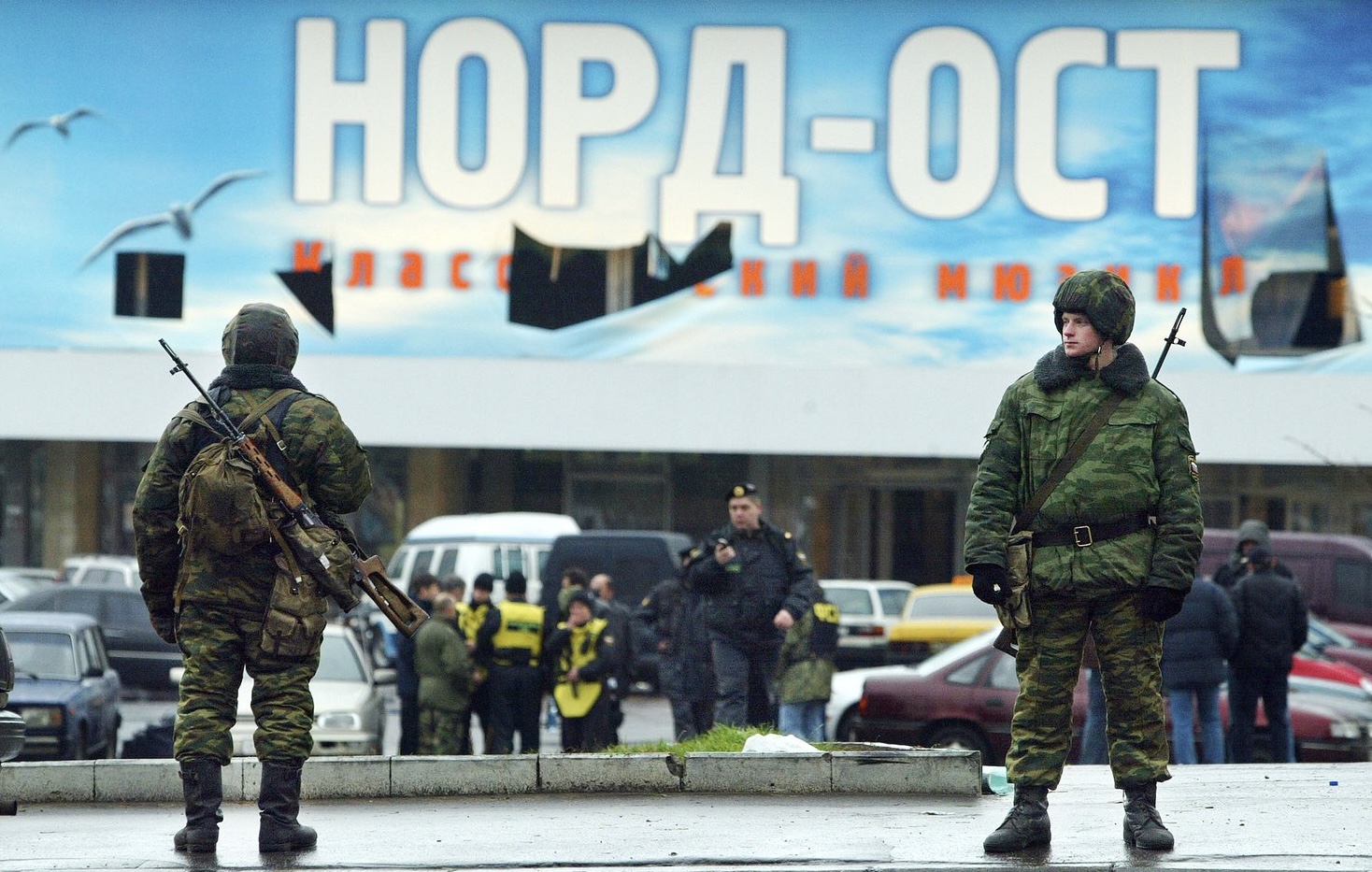
Since its inception and for many years, the study of fentanyl derivatives has been a priority in the development of incapacitating agents in Russia and the USA. With a slight delay, China joined the “fentanyl race,” synthesizing the two most potent fentanyl analogs — ohmefentanil and ohmecarfentanil. Later, research on incapacitating agents in this group was undertaken in Iran, India, South Africa, and other countries.
Retired general of the Ministry of Defence Chemical Protection Troops N. S. Antonov in his monograph (1992) commended the the military chemical potential of fentanyl incapacitants:
"With sudden use, when an enemy is caught unaware, the effect of the application of narcotic analgesics and emetics can be stunning. The effect of analgesics is incapacitating — troops under attack several minutes after the beginning of a gas attack lose the capacity to stay on their legs, not to mention move. In severe cases, people fall into an unconscious state."[1]
However, not all researchers shared the optimism regarding the new non-lethal agents. The British Chemical Defence Establishment (CDE) at Porton Down ceased further study of opioid analgesics, as researchers were convinced that it was impossible to develop an incapacitant with a mortality rate of less than 2% — a necessary requirement for non-lethal chemical agents.
In medicine, to assess the safety of fentanyl-type analgesics, the therapeutic index (or safety margin) is used – the ratio of the median lethal dose LD50 to the median effective dose ED50 (LD50/ED50). Carfentanil and remifentanil are classified as incapacitating agents on the basis that they supposedly have a therapeutic index of 10,500 and 33,000 respectively. In the calculations, the ED50 is taken as the average analgesic dose for rodents. However, rodents are thousands of times more resistant to the depressive effects of opioids on the respiratory center than humans. In humans, a dose of fentanyl reducing pain intensity by 50% causes respiratory depression in more than 50% of cases.[80] Anesthetic doses of fentanils almost always cause dangerous respiratory depression.
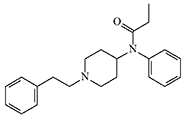 |
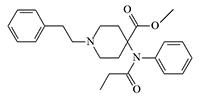 |
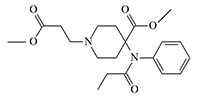 |
| Fentanyl | Carfentanil | Remifentanil |
The US Joint Non-Lethal Weapons Directorate (JNLWD) defines a non-lethal chemical weapon as one that incapacitates 98% of the target population while causing fewer than 0.5% fatalities.[3] Klotz et al. (2003), using mathematical modeling, demonstrated that incapacitants with a therapeutic index in humans above 10,000 meet these requirements.[27] For carfentanil and remifentanil, which are components of the Russian "narcotic gas," the therapeutic index is less than 1.
The tragic experience of using carfentanil and remifentanil in the operation to rescue hostages in 2002, which ended in the deaths of 130 people, does not allow us to attribute the substances of this group to incapacitants. According to British scientists from the Defense Science and Technology Laboratory (Dstl),
"literature data suggest little margin of safety between their therapeutic and lethal doses in humans, and a high lethality in the absence of prompt and appropriate medical intervention. It is highly improbable that a chemical agent exists for which a dose can be calibrated in a tactical environment to incapacitate opponents reliably and without substantial mortality".[4]
Military use of Fentanils
The use of fentanils aerosol in 2002 for hostage rescue confirmed Russia's extensive experience in the development and production of this group of non-lethal chemical agents. It had long been suspected that Soviet chemical arsenals contained incapacitating agents. Renowned military historian David C. Isby claims (but does not provide any evidence) that narcotic gas was first used during theSino-Soviet border clashe in 1969.[5]
Russian scientist Lev A. Fedorov, a former chemical warfare officer, in his monograph dedicated to the history of Soviet chemical weaponry, writes about the USSR's readiness to use non-lethal chemical weapons against "Chinese aggressors".[6] This claim does not seem too fantastical — in the 1940s and 1950s, the Ministry of State Security of the USSR used narcotic gases "Neptune-7/93" and "Typhoon" in their fight against Ukrainian insurgents. These gases were pumped into the underground shelters of Ukrainian nationalists through ventilation openings (See details).
In the 1960s, the USSR developed a simple and inexpensive method for the industrial production of fentanyl and its analogs (See details), as well as established experimental production of psychotropic chemical agents. It is likely that in the 1970s and 1980s, the USSR began using conflict zones in Southeast Asia and Afghanistan as proving ground for chemical weapons. The US Department of State in 1982 presented clear and convincing evidence of the Soviet Army's use of narcotic gas in Laos, Cambodia, and Afghanistan.[5]
The chemical agent known as "Blue-X" had such a lightning-like effect that a person would fall asleep almost instantly, and when they came to, they would notice that they were still in the same position as they had been in seconds before exposure to the gas. U.S. intelligence assumed that this name hid the already well-known in those years carfentanyl[7]. Carfentanyl is a very toxic compound, and its use has often resulted in death. In 1981, of 15 refugees exposed to Blue-X, 4–5 died (the youngest and the eldest), while the rest became unconscious for 5–6 hours.[5] In 1990, fentanyl was included in the US Army Field Manual "Potential Military Chemical/ Biological Agents and Compounds."
Given the extremely high toxicity of fentanils, its effects are more similar to those of lethal chemical agents described in American sources under different names — "Instant Death", "Sleeping Death"[8] and "The Flash". These chemical agents were colorless and odorless and killed in a flash: "Only once has it left hard evidence: a firing line of Afghan guerrillas, peering through the sights of their rifles, cold, stone dead — as if frozen". Those who died from it, in the words of a State Department official, "Just forgot to breathe."[5]
Political Assassinations Using Fentanils
Pakistan. August 17, 1988, an airplane carrying the President of Pakistan Mohammed Zia ul-Haq crashed. The most probable cause of the crash is considered to be the exposure to gas that rendered the passengers and the pilots unconscious resulting in the crash of the plane. Initially, the chemical agent VX was considered as the most likely poison. However, VX has low volatility, which makes it impossible to quickly create a lethal concentration. Later, a senior chemical weapons expert told Defense and Foreign Affairs Weekly that 3-methylfentanyl was most likely used. Probably, a solution of this opioid was applied to the control devices and headphones in a dose sufficient to completely disorient the flight crew after some time.[9] Another chemical warfare expert, in a private communication, suggested that the equally potent opioid carfentanil may have been used for this political assassination.[10]
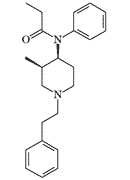 |
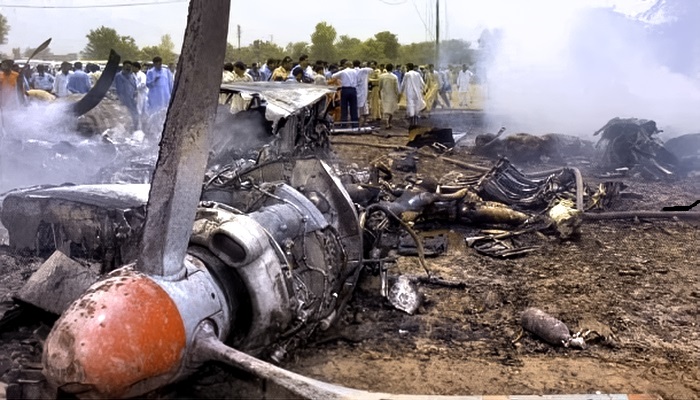 |
| 3-Methylfentanyl | The crash site of the plane carrying the President of Pakistan Mohammed Zia ul-Haq |
The president Zia ul-Haq had many powerful enemies: the Soviets and their Afghan allies, India, the United States, Israel, and also Inter-Services Intelligence (ISI) and the Shia community in his homeland. We will probably never find out the full truth about death or murder of the President of Pakistan. The US government has not disclosed details of the investigation into the crash, and the US National Archives has not declassified some 250 pages related to the accident.[9]
Israel. "Potion of the gods" was the name given to Levofentanyl by Israeli intelligence agency Mossad. In 1997, Mossad used a fentanyl derivative, levofentanyl, to eliminate Khaled Mashal, the head of the politburo of the Palestinian terrorist group Hamas, who was hiding in Jordan. A substance called Levofentanyl does not exist; it was most likely the most potent known opioid at the time — Lofentanyl (or LEVO-methylcarFENTANIL). The drug was synthesized at the Israel Institute for Biological Research (IIBR) and its lethal dose was so small that it could not be detected in the blood by any of the known methods at that time. IIBR designed a special ultrasonic sprayer in the form of a cylinder, easily fitting in the palm. The device generated a stream of anesthetic that felt like a light breeze of moist air. At the moment of the assassination attempt, a second operative was supposed to open a Coca Cola can next to the target so that tiny droplets of the drink could mask the aerosol spray. The poison acted slowly, initially causing severe drowsiness, then a coma, and death from respiratory arrest.[11]
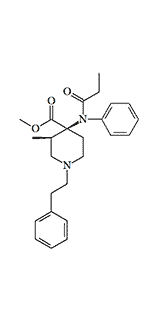 |
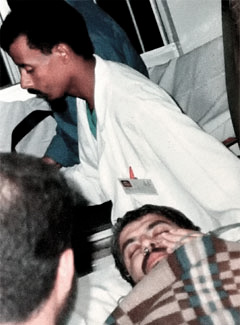 |
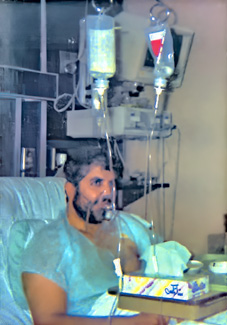 |
| Are Lofentanil and Levofentanyl the same thing? | Khaled Mashal is hospitalized after poisoning (left) and after coming out of a coma (right) | |
The Israeli operatives managed to spray the poison on the victim's skin, but during the operation, two members of the team were captured, and four others managed to take refuge in the Israeli embassy. As the organizers had planned, Khaled Mashal soon fell into a coma, stopped breathing on his own, and was placed on a ventilator. However, since the assassination attempt was exposed, King Hussein of Jordan intervened, threatening to execute the captured Israelis. The Israeli government had no choice but to hand over the antidote, which saved Mashaal's life. However, Jordanian doctors considered the Israeli antidote, which turned out to be naloxone, useless. They administered it to Mashaal multiple times without any apparent effect, and only continuous ventilation until the poisoning symptoms completely disappeared saved his life.[11]
Counter-terrorist Use of Fentanils
Russian Federation. In 2002, during the hostage rescue operation at Dubrovka Theater in Moscow, an unknown narcotic gas was used to immobilize the terrorists, resulting in the deaths of 132 people. According to an official statement from the Federal Security Service (FSB), the drug was a "special formulation based on fentanyl derivatives."[27]. German toxicologist Thomas Zilker confirmed that an American laboratory had found traces of two fentanyl derivatives in the analyses of German victims of an unknown gas. However, at the request of the U.S. side, he declined at the time to inform the media of the exact names of the opioids used.[12].
Ten years after the storming of the Dubrovka theater complex, in 2012 the British Defense Science and Technology Laboratory (Dstl) published a report on the results of analyses of blood, urine, and clothing samples of three British victims of the attack. Carfentanil, remifentanil, and their metabolites were detected in the analyses.[13].
United States. In 1980, during the development of the operation to rescue American hostages held in the U.S. embassy in Iran, a psychopharmacologist was planned to be part of the assault team. His task was to neutralize the Islamist students guarding the embassy staff and any other enemy forces that might resist[14]. This was a mandatory condition set by President Jimmy Carter, who insisted that no Iranians be harmed during the operation[15].
The Czech scientist L. Hess (2014), who studied ultra-potent opioids, mentions in his article that American special forces used carfentanil aerosol during the assault on Tora Bora in 2001.[16] This cave complex in northern Afghanistan was hiding the number one terrorist, Osama bin Laden. L. Hess does not cite the source of this information, but it could be his colleague, Prof. Theodor H. Stanley (1940–2017) from the University of Utah, who was a consultant on the FBI and CIA hostage rescue team. There is no official confirmation of this information.
Israel. There were multiple plans, but the special units of Israel never decided to use sleeping gas. The first instance was in 1976 during Operation Entebbe, when pro-Palestinian terrorists hijacked a passenger plane to Uganda, and the second was in 1994, when the terrorist group Hamas kidnapped an Israeli soldier. The kidnapped soldier was hidden in a house on the outskirts of a small village, with all approaches to the location well monitored. In both cases, the Israeli command decided against using the gas due to concerns that innocent people might be harmed during the operation or that the international community might condemn the actions as an attempt to use chemical weapons[17].
In 2002, Israeli intelligence planned to use sleeping gas during the raid on the residence of Chairman of the Palestine Liberation Organization, Yasser Arafat. However, the operation to capture the Palestinian leader was canceled because the doctor involved in its planning stated that "we couldn't ensure that Arafat would come out of all this alive".[11]
In 2001 a retired officer of the IDF referred to "sleeping gas", an aerosol dispersed gas that induces fatigue and sleep”. Its effects, he went on to say, “depend on weather conditions”.[18] Given the concerns of the Israeli military about possible lethal consequences, the likely components of the 'sleeping gas' were fentanyl derivatives.
China: Undeclared Chemical War
Due to its extremely small single narcotic dose, carfentanil is ideal for drug trafficking — 1 kg of carfentanil is equivalent to 4 tons of heroin[19]. Over the past decade, illegal carfentanil has rapidly spread across the USA and Western Europe. By 2016, carfentanil ranked fourth among fentanyl derivatives found in drug samples submitted to forensic laboratories in the USA[20]. In the USA, carfentanil accounts for more than half of deaths caused by fentanyl derivative overdoses. In 2016, within just six months, 389 people in ten states died from fatal carfentanil overdoses, three times the number of casualties during the siege of the Dubrovka theater center[21].
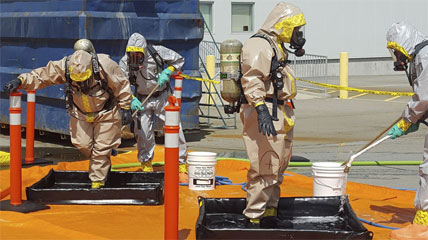
Canadian police are decontaminating after an operation to confiscate about 1 kg of carfentanyl shipped from China (Associated Press photo). |
 The lethal dose of carfentanil as low as 0.02 mg (or 1/50,000 of a gram) |
In the European Union, carfentanil appeared on the illegal market at the end of 2012[22], and in the same year, the first fatalities caused by carfentanil overdoses were recorded in Belarus[23]. The largest number of carfentanil seizures by police occurred in the Baltic countries, but the UK leads in the number of deaths.
A serious terrorist threat is the ease of acquiring large quantities of carfentanil from Chinese chemical companies. A journalistic investigation titled "Chemical weapon for sale: China’s unregulated narcotic," published by the Associated Press in 2016, revealed that at least 12 Chinese firms were willing to export carfentanil for as little as $2750 per kilogram. Meanwhile, the Ministry of Public Security of the PRC refuses to comment on the matter.[25].
In 2019, the People's Republic of China (PRC) classified fentanyl-related substances as a controlled class, effectively halting shipments of these substances from the PRC to the United States. However, transnational criminal organizations have adapted to this change by using precursor chemicals sourced from the PRC to synthesize fentanyl, methamphetamine, and other synthetic drugs in Mexico and across the globe.[26]
Michael J. Morell, Former Acting Director, CIA[24]
In 2022, during a congressional briefing, a case was made for designating illicit fentanyl as a weapon of mass destruction.[27]